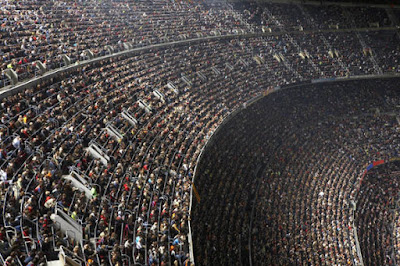Hawaii.....us Moving away......
The floor of the Pacific Ocean is divided into several plates. The largest one, the Pacific Plate is moving north west relative to the plate that holds North America, and relative to hot spots coming up through the mantle from below the plates (they generate islands like Hawaii).
On the surface of the earth, nothing can move along a straight line, instead the plates rotate around a point on the surface. The pacific plate rotates around a point south of Australia. Around Hawaii, the plate is moving at about 7 cm/year, or about as fast as finger mails grow.
The evidence for this motion is pretty convincing:
Earthquakes: earthquakes occur on the boundaries of the plates as they rub past each other. The motion observed during these earthquakes agrees well with the expected motion.
Absolute measurements: Thanks to the Global Positioning System navigation system, we can now measure the location of any point on the earth to within a few cm. The observed motions agree with expected plate motions.
Plate boundaries: where two plates meet there can be three types of boundaries: transform faults where the plates slide past each other (like the San Andreas fault); spreading centers where two plates are moving away from each other (like the Juan de Fuca spreading center off the Pacific NW and the mid-Atlantic Ridge; and subduction zones where one plate dives into the earth under another plate (Aleutian Islands, Japan). All the observed boundariies should agree with the expected motions - and they do.
Magnetism: new rock is added to the the plates at spreading centers as they split apart. As this lave cools, it becomes magnetized, much like a magnetic tape does in your tape recoder. When the magnetic field of the earth changes, this change is recorded in the rocks. We can read this record by sensing the changes in the magnetic field from ships, and we see stripes of different magnetism parallel to the spreading centers, as expected if the plates are splitting apart there.
Sediments: in the deep ocean there is a very slow but continuous rain of mud that slowly settles to the ocean bottom and forms layers of sediment. Since the ocean floor is youngest near the spreading centers, we would expect very little sediment there, and the layers should get thicker the farther you get from a spreading center. This is observed, and the age of the oldest (deepest) fossils in the sediment obtained by drilling in the ocean floor gives us an idea of the age of the ocean floor at that spot. Studies show that the ocean floor gets older as you get farther away from spreading centers, and that the OLDEST ocean floor on the earth today is only about 200 million years old. That may sound very old, but the oldest FOSSILS are over 3 BILLION years old.
There is more evidence, and you can read about it in a good geology text book.
......................Urdu Translation.....................
بحر الکاہل کی منزل کو کئی پلیٹوں میں تقسیم کیا گیا ہے۔ سب سے بڑا ، بحر الکاہل کی پلیٹ شمال مغرب کی طرف بڑھ رہی ہے جو اس پلیٹ کے مقابلہ میں ہے جو شمالی امریکہ کو رکھتی ہے ، اور پلیٹوں کے نیچے سے اندر آتے ہوئے گرم دھبوں کے مقابلہ میں (وہ ہوائی جیسے جزیرے تیار کرتے ہیں)۔
زمین کی سطح پر ، کچھ بھی سیدھی لکیر کے ساتھ نہیں بڑھ سکتا ، اس کے بجائے پلیٹیں سطح کے ایک نقطہ کے گرد گھومتی ہیں۔ پیسیفک پلیٹ آسٹریلیا کے جنوب میں ایک مقام کے گرد گھومتی ہے۔ ہوائی کے آس پاس ، پلیٹ تقریبا 7 7 سینٹی میٹر / سال کی رفتار سے بڑھ رہی ہے ، یا فنگر ای میلوں کی تیزی سے تیزی سے بڑھتی ہے۔
اس تحریک کے ثبوت بہت قائل ہیں:
زلزلے: پلیٹوں کی حدود پر زلزلے آتے ہیں جب وہ ایک دوسرے سے گذر جاتے ہیں۔ ان زلزلوں کے دوران دیکھنے میں آنے والی تحریک متوقع تحریک کے ساتھ اچھی طرح متفق ہے۔
مطلق پیمائش: عالمی پوزیشننگ سسٹم نیویگیشن سسٹم کی بدولت ، اب ہم زمین پر کسی بھی مقام کا محل وقوع چند سینٹی میٹر میں ماپ سکتے ہیں۔ مشاہدہ کی حرکات متوقع پلیٹ موشن سے متفق ہیں۔
پلیٹ کی حدود: جہاں دو پلیٹیں ملتی ہیں وہاں تین طرح کی حدود ہوسکتی ہیں: نقائص کو تبدیل کرنا جہاں پلیٹیں ایک دوسرے سے گذرتی ہیں (سان اینڈریس فالٹ کی طرح)۔ پھیلانے والے مراکز جہاں دو پلیٹیں ایک دوسرے سے ہٹ رہی ہیں (جیسے پیسیفک شمال مغربی سرحد اور وسط بحر اٹلانٹک رج سے جوآن ڈی فوکا پھیلانے والا مرکز and اور سبڈکشن زون) جہاں ایک پلیٹ دوسری پلیٹ کے نیچے زمین میں ڈوبتی ہے (الیشیان جزیرے ، جاپان)۔ تمام مشاہدہ کی حدود کو متوقع حرکات سے اتفاق کرنا چاہئے - اور وہ کرتے ہیں۔
مقناطیسیت: پھیلانے والے مراکز میں پلیٹوں میں ایک نئی چٹان شامل کی جاتی ہے جب وہ الگ ہوجاتے ہیں جیسے جیسے یہ لیو ٹھنڈا ہوتا ہے ، یہ مقناطیسی بن جاتا ہے ، جیسے مقناطیسی ٹیپ آپ کے ٹیپ ریکوڈر میں کرتا ہے۔ جب زمین کا مقناطیسی میدان بدل جاتا ہے تو یہ تبدیلی چٹانوں میں درج ہوتی ہے۔ ہم بحری جہازوں سے مقناطیسی میدان میں ہونے والی تبدیلیوں کو سمجھ کر یہ ریکارڈ پڑھ سکتے ہیں ، اور ہم مختلف مقناطیسیت کی دھاریوں کو پھیلتے ہوئے مراکز کے متوازی دیکھتے ہیں ، جیسا کہ توقع کی جاتی ہے کہ اگر پلیٹیں وہاں سے الگ ہو رہی ہیں۔
تلچھڑے: گہرے سمندر میں کیچڑ کی ایک بہت ہی سست لیکن مستقل بارش ہوتی ہے جو آہستہ آہستہ سمندر کی تہہ تک رہ جاتی ہے اور تلچھٹ کی تہوں کی شکل دیتی ہے۔ چونکہ پھیلانے والے مراکز کے قریب سمندری فرش سب سے کم عمر ہے ، لہذا ہم وہاں بہت تھوڑا سا تلچھٹ کی توقع کریں گے ، اور آپ کو پھیلاؤ والے مراکز سے تہوں کی لمبائی زیادہ گہری ہوجانی چاہئے۔ یہ مشاہدہ کیا جاتا ہے ، اور سمندر کے فرش میں ڈرلنگ کے ذریعے حاصل کیے جانے والے تلچھٹ میں قدیم ترین (انتہائی گہرے) جیواشموں کی عمر ہمیں اس جگہ پر سمندری فرش کی عمر کا اندازہ فراہم کرتی ہے۔ مطالعات سے پتہ چلتا ہے کہ جب آپ پھیلنے والے مراکز سے دور ہوتے جاتے ہیں تو سمندر کا فرش لمبا ہوجاتا ہے ، اور یہ کہ زمین پر آج کل اولڈسٹ سمندر کی منزل صرف 200 ملین سال قدیم ہے۔ یہ بہت پرانی لگ سکتی ہے ، لیکن سب سے قدیم FOSSILS 3 بلین سال سے زیادہ پرانی ہے۔
اس کے علاوہ اور بھی شواہد موجود ہیں ، اور آپ اس کے بارے میں ایک اچھی جیولوجی ٹیکسٹ بک میں پڑھ سکتے ہیں۔











Comments
Post a Comment